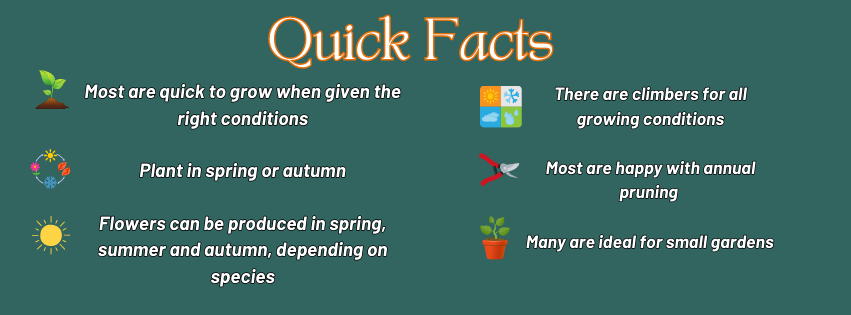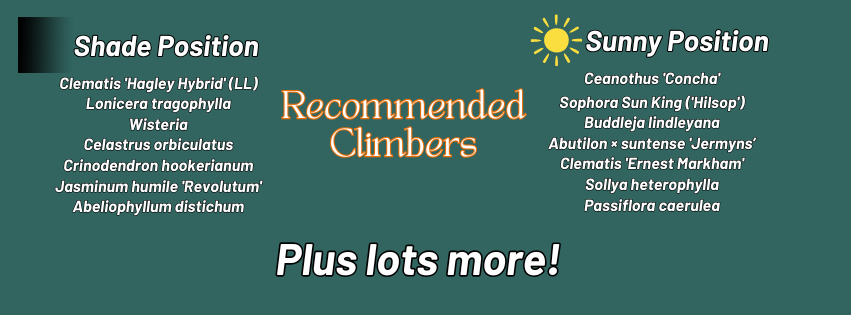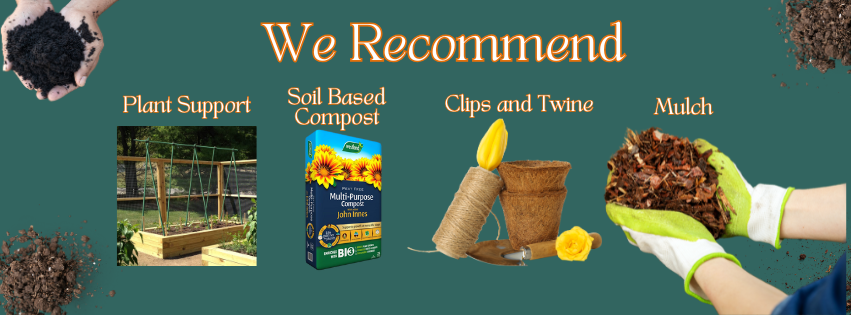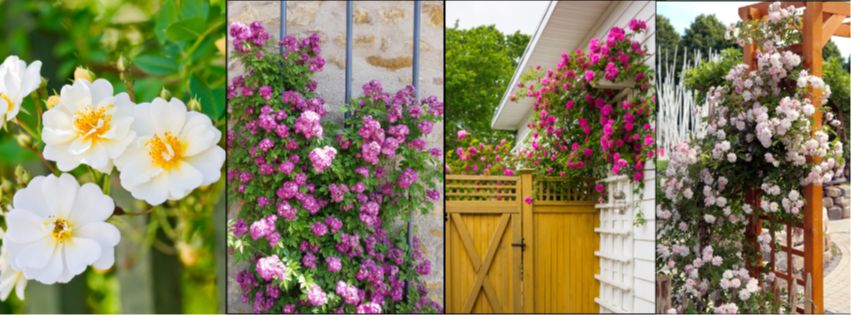How to grow climbers and wall shrubs
Climbers and wall shrubs are an excellent choice for transforming plain walls, fences, obelisks, and garden supports, especially in areas with limited planting space. With a wide variety to suit any location, they also offer valuable shelter and food for wildlife.

Choosing the Right Climbers and Wall Shrubs
With a vast variety available, there are climbers and wall shrubs to suit every garden condition, from full sun to deep shade, and a wide range of soil types. For help understanding your garden's environment, refer to our guide on assessing conditions.
Many options are hardy, while some wall shrubs are grown against walls specifically for the extra warmth and protection a sunny spot provides.
For a splash of vibrant, exotic color, consider tender or half-hardy climbers. These can be grown as seasonal features during the summer or kept as conservatory plants.
When selecting a wall plant, consider the space you have available. While they take up minimal ground space, some can grow vigorously both upward and outward. Be sure to check the plant's label for its eventual height and spread.
Most wall shrubs and many climbers need a strong support system, such as sturdy wires or trellis, installed before planting. Wall shrubs require regular tying to these supports as they grow. Certain climbers, like grapevines and passionflowers, use tendrils to grip securely, while others, such as climbing roses, need to be manually tied in. A few climbers, including ivy, campsis, and Virginia creeper, can attach directly to vertical surfaces without additional support.

When to Plant
The ideal time to plant wall shrubs and climbers is in spring or autumn they can also be planted during summer months too but will require additional water when planting and check plants daily so they don't be come too dry. Less hardy varieties should be planted in spring to allow them ample time to establish before winter.
For annual climbers, sow seeds indoors during the spring.
Where to Plant
Wall shrubs and climbers should be planted approximately 45cm (18in) away from the base of a wall. This ensures the roots receive sufficient rainwater and avoid the dry, poor-quality soil often found directly at the base of walls. Planting at this distance also prevents roots from being constrained by foundations or rubble. Position the plant at an angle towards the wall or fence so it can grow against it.
Similarly, when planting climbers to grow into a tree, dig the planting hole about 50cm (20in) away from the trunk and clear of the main roots. Use a bamboo cane if needed to guide the climber towards its permanent support.
There are plants suited to all conditions, from full sun to deep shade. Always check plant labels to ensure you select a variety that matches your garden's environment, as the wrong choice may struggle to thrive.
Prepare your soil
Most climbers and wall shrubs like free-draining soil, so add plenty of garden compost, or leaf mould to the entire planting area to improve the soil structure. This also helps the soil to retain moisture during the summer, as well as increasing soil fertility and beneficial soil microorganisms
How to plant
Planting climbers and shrubs is straightforward and they should settle in quickly.
Aftercare
Water your new plant regularly throughout the first growing season, particularly during hot, dry, or windy weather.
Pruning after planting can help some plants establish more effectively. Many climbers also benefit from annual pruning to keep them manageable and encourage flowering at lower levels. Refer to our guides on initial pruning of climbers and pruning established climbers for more detailed advice.
Tie in new shoots as needed. Some plants may require guidance to climb their support or grow in the desired direction. Regularly check that new growth is not straying, as unattached shoots are vulnerable to damage from wind. Use soft twine to loosely secure them to the support.
Replenish the mulch annually to help retain soil moisture and support healthy growth.

Watering
Water newly planted climbers and wall shrubs regularly during their first growing season, until they are well established.
For plants in containers, water whenever the surface of the compost dries out, continuing throughout the growing season.
Pay extra attention to plants located in the rain shadow of walls or fences, or under house eaves, as they may not receive adequate natural rainfall. These areas are particularly prone to drying out in summer, so regular watering is essential.
Feeding
To boost flowering, you can apply a high potassium fertiliser, at the dose recommended on the packet. our recommended fertiliser is Westland Sulphate of potash Fertiliser Granules.
.png)
Weeding
To keep wall plants healthy, ensure the ground around their base is free of weeds. Weeds compete for water and nutrients and can also harbour pests.
Applying a mulch around the base of the plant helps suppress weed growth and provides additional benefits. Mulch is a layer of material, at least 5cm (2in) thick, applied to the soil surface from late autumn to late winter (November–February). It can:
- Protect against frost
- Improve soil quality by adding nutrients and organic matter
- Reduce water loss
- Enhance the garden's appearance
- Suppress weed growth
Common mulch materials include well-rotted garden compost, manure, chipped bark, gravel, grit, and slate chippings. By creating a barrier, mulch also helps deter the germination of weed seeds in the soil.
Pruning and Training
Newly planted climbers and wall shrubs require initial training and pruning at the time of planting. This helps them spread out to fill their allocated space and develop a pleasing shape. For detailed advice, refer to our guide on initial pruning and training.
Annual pruning is essential to keep wall plants tidy, attractive, and flowering well. Follow our step-by-step pruning guide to ensure the best results.
Some plants, such as campsis, climbing roses, clematis, honeysuckle, wisteria, and espalier-trained varieties, have specific pruning requirements.
If regular pruning is neglected, renovation pruning may be needed to revitalise the plant and restore its shape.

Shop online
View our massive range of stock online